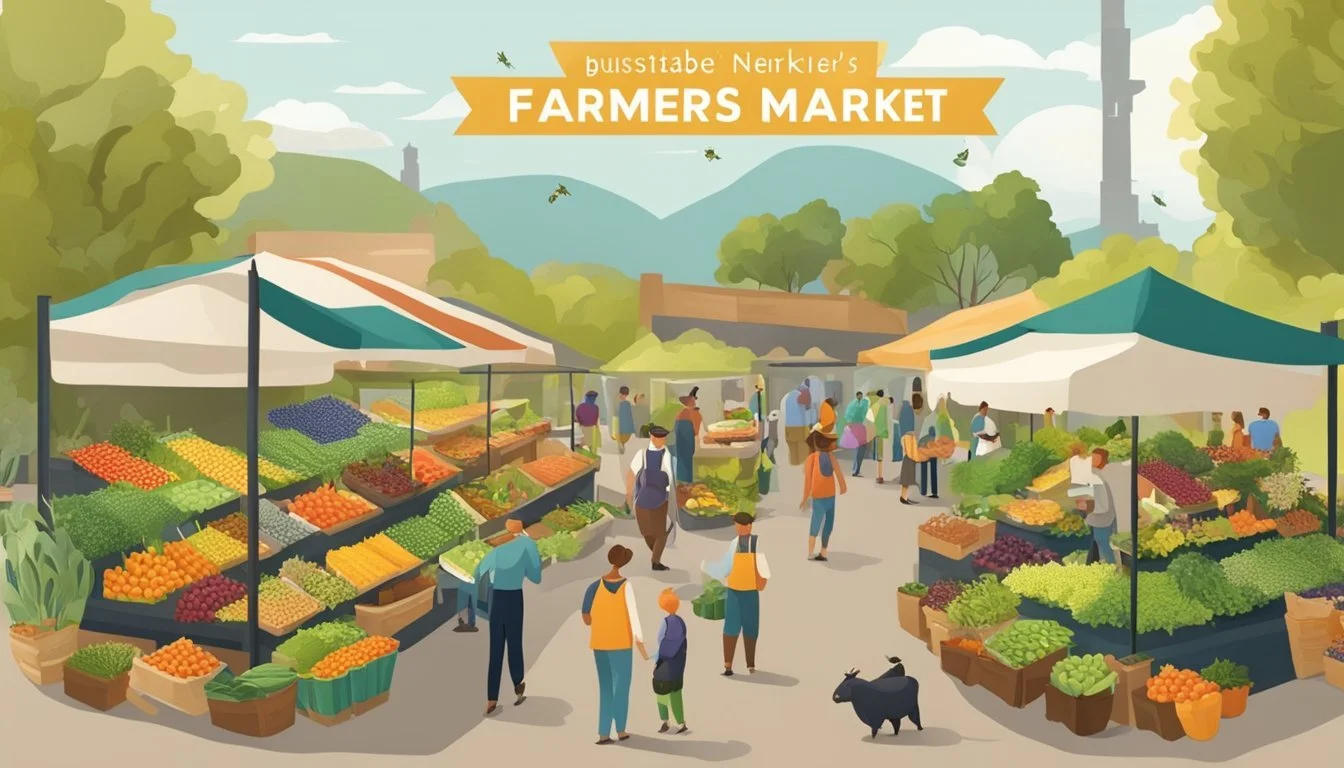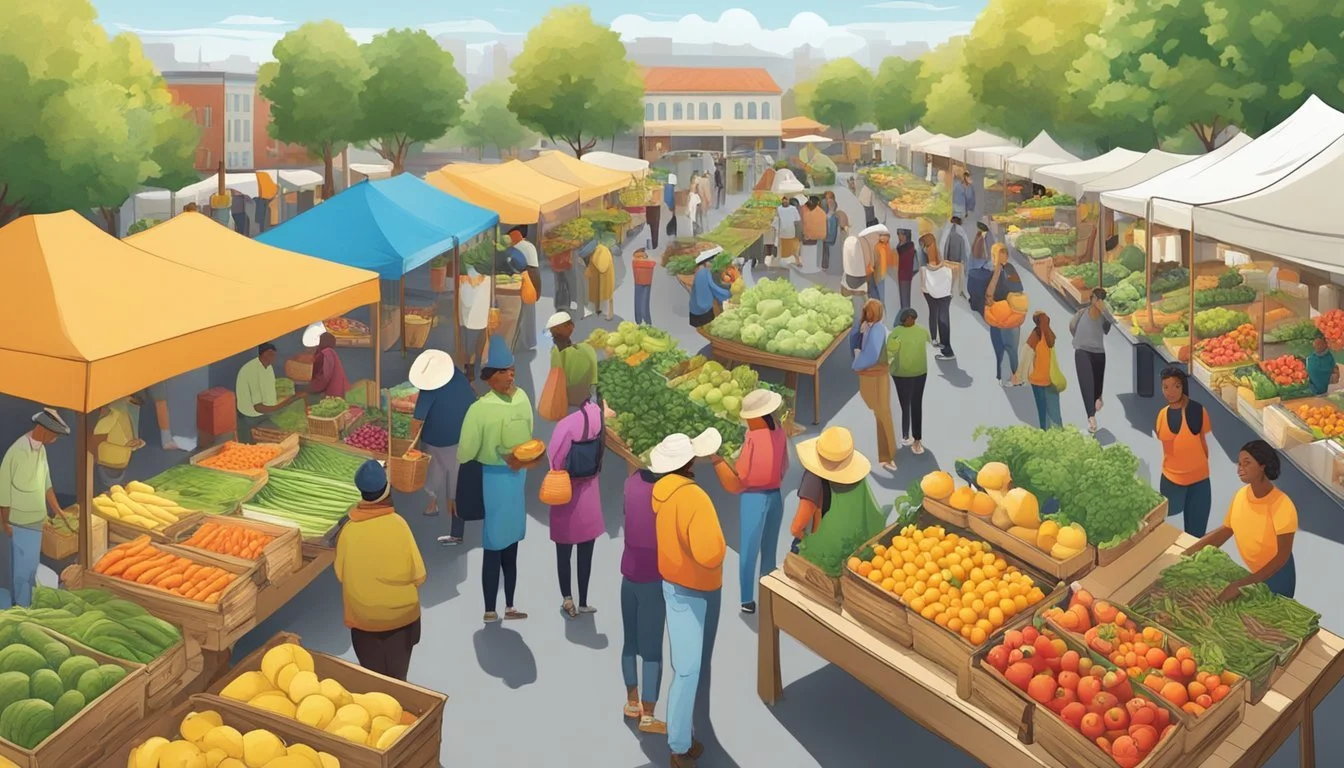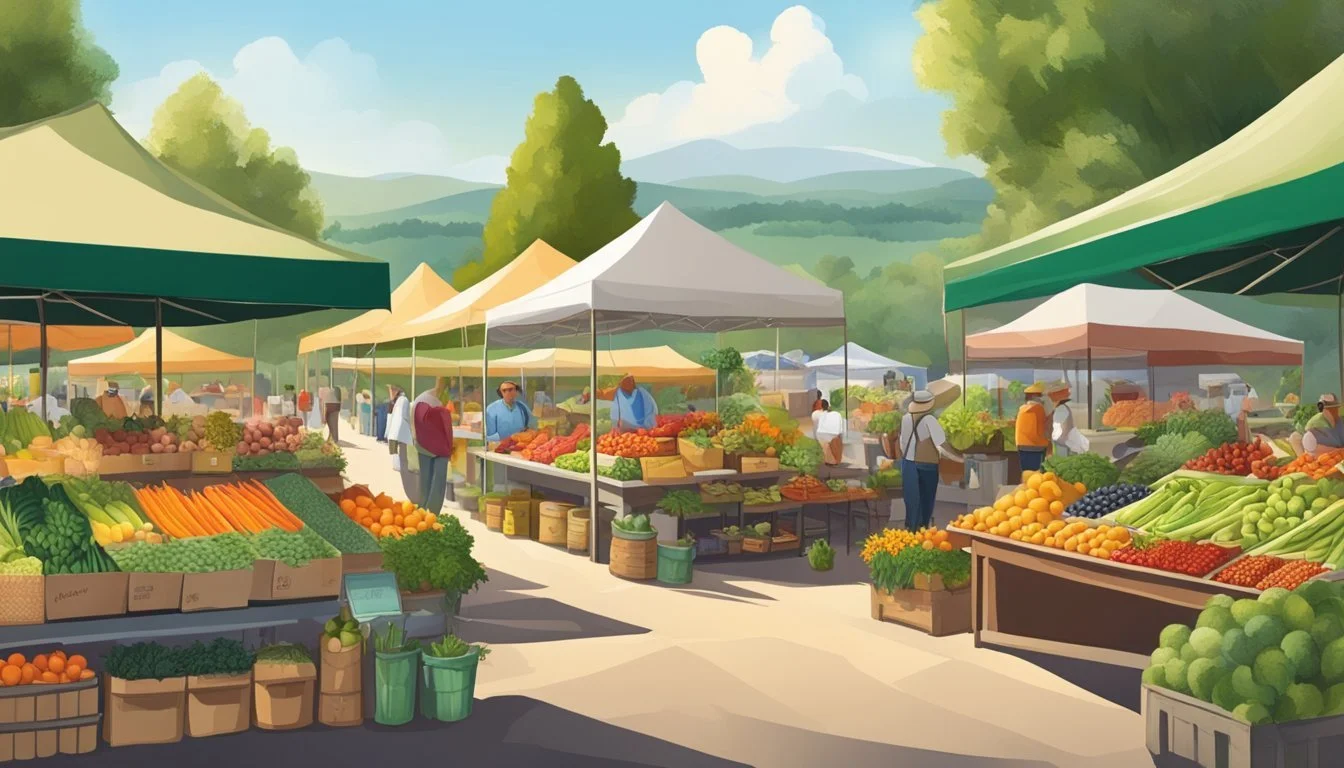The Connection Between Farmers' Markets and Biodiversity
An Analysis of Ecological Impact
The nexus between farmers' markets and biodiversity is both intricate and significant. As vibrant hubs for the community and local economy, farmers' markets serve as critical channels by which small-scale farmers reach consumers seeking fresh, local produce. This direct marketing model not only bolsters local economies but also fosters biodiversity. By primarily featuring an array of locally grown crops, often including heirloom varieties and less common species, these markets can help sustain a wide range of plants and animals within agricultural systems.
Biodiversity is vital in agriculture as it enhances resilience and ecosystem services, such as pollination and natural pest control. Smaller farms, which rely less on monoculture and more on diverse crop rotations, often find their place at farmers' markets, offering produce that reflects the biodiversity of their farming practices. Consequently, these farming operations can contribute to the conservation of diverse species by maintaining varied habitats and genetic diversity within their agricultural lands.
The relationship between farmers' markets and biodiversity extends beyond the environmental implications to social and economic dimensions. Markets that connect local producers with consumers help shape opinions and knowledge about the importance of sustainability and biodiversity in agriculture. As people become more aware of where their food comes from, they may be more likely to support farming methods that protect and enhance biodiversity, creating a positive feedback loop that benefits the environment, producers, and consumers alike.
The Importance of Biodiversity in Agriculture
Biodiversity plays a crucial role in agricultural productivity and environmental health. It sustains an array of ecosystem services essential for crop and livestock production.
Understanding Biodiversity
Biodiversity encompasses the variety of life at the genetic, species, and ecosystem levels. Agricultural biodiversity is a subset of this biological diversity, including the domesticated plants and animals raised in crop, livestock, forest, and aquaculture systems, as well as the associated wild species. It is vital for the development and improvement of agriculture, ensuring resilience to pests, diseases, and changing climate conditions.
Biodiversity and Ecosystem Services
Ecosystem services are the benefits that humans obtain from ecosystems. In agriculture, biodiversity contributes to:
Soil formation and protection, which encompasses nutrient recycling and retention.
Pollination of plants, providing critical support for the reproduction of crop species and others.
Pest control through the presence of natural predators, reducing the need for chemical interventions.
Genetic diversity which is essential for breeding programs aimed at improving resistance to diseases and adaptation to environmental changes.
The diverse array of plants and animals in agricultural landscapes supports these services and helps maintain a balance within the environment.
The Impact of Biodiversity Loss on Agriculture
Biodiversity loss on farmland reduces the ability of agricultural systems to remain resilient against environmental stressors. The consequences include:
Increased vulnerability to pests and diseases, potentially leading to higher crop losses.
Reduced effectiveness of natural pollinators, affecting crop yields and quality.
Compromised soil health and structure, which can affect water availability and nutrient uptake by plants.
Protecting and enhancing biodiversity is essential for agricultural productivity and sustainability. Efforts to mitigate biodiversity loss must be integrated into farming practices to ensure the long-term viability of agriculture and the conservation of the environment.
Farmers' Markets as a Catalyst for Biodiversity
Farmers' markets are instrumental in encouraging sustainable agricultural practices and bolstering biodiversity. They provide a unique intersection for farmers to offer a wider array of crops, support local wildlife habitats, and promote organic farming methods.
Promoting Agricultural Diversity
Farmers' markets demand a variety of produce, which incentivizes farmers to plant multiple crop species. This multiplicity of crops not only meets the diverse demands of consumers but also contributes to the genetic variation necessary for a resilient agricultural system. Diverse planting strategies can lead to a 79% increase in yields on smaller farms, underscoring the value of crop diversity.
Supporting Local Ecosystems
Small-scale agriculture, often found at farmers' markets, plays a crucial role in maintaining local ecosystems. By preserving varied habitats on their lands, farmers aid in safeguarding regional flora and fauna. This multifunctionality of farmers' markets and the agricultural land they represent enhances the surrounding biodiversity.
Sustainable Development: By maintaining a mixture of crops and native plants, these smallholders support a cross-section of species, contributing to sustainable development goals.
Diversity Conservation: The conservation of local plant and animal species becomes a by-product of their terrestrial stewardship.
Organic Farming and Its Role in Biodiversity
Organic farming, a frequent characteristic of farmers' market offerings, emphasizes the elimination of synthetic pesticides and fertilizers. The absence of these chemicals creates a safe haven for beneficial insects and organisms, contributing to an overall increase in biodiversity.
Soil Health: Organic practices improve soil health, forming a nurturing foundation for diverse plant life.
Pollinator Protection: Opting for organic means protecting pollinators against harmful substances, ensuring the continuation of essential pollination services.
Farmers' markets thus act as engines for biodiversity through supporting diversified agriculture, enhancing local ecosystems, and encouraging organic farming practices.
Conservation Efforts Through Farmers' Markets
Farmers' markets serve as a nexus for sustainability, linking conscientious consumption with environmental conservation. Here, efforts to reduce the ecological footprint are given practical shape through various agricultural practices.
Reducing Pesticide Use
Farmers' markets promote the sale of organic and locally grown produce. This directly leads to a decrease in pesticide use, as small-scale producers often employ organic farming methods. Agroecological practices such as integrated pest management (IPM) are encouraged, which focus on natural pest control mechanisms that diminish the need for chemical pesticides.
Benefits:
Healthier soil: Less pesticide leads to improved soil quality.
Safer food: Reduced chemical residue on produce.
Water conservation: Minimizing chemical runoff preserves water quality.
Encouraging Crop Diversification
Crop diversification stands at the heart of resilience against pests and diseases, leading to less reliance on pesticides. Farmers' markets drive demand for a variety of local produce, which in turn incentivizes farmers to diversify their crops.
Implementations:
Crop rotations: Alternating different crops to improve soil health and reduce pest cycles.
Heritage and heirloom varieties: Often adopted by small-scale farmers for their unique qualities and adaptations to local conditions.
Fostering Farmland Biodiversity
The sales channels created by farmers' markets underpin landscape-level biodiversity. They achieve this by supporting farming practices that accommodate wildlife habitats alongside crop areas. Biodiversity conservation becomes intertwined with farming, where diverse ecosystems support natural pest regulation and pollinators.
Key practices:
Hedgerows and wildflower borders: Introducing native plant species that support a range of wildlife.
Mixed-use farming: Integrating livestock into crop systems to create balanced ecosystems.
By continuing to support farmers' markets, consumers play an active role in advancing environmental conservation efforts that extend far beyond the marketplace.
Challenges and Opportunities in Balancing Trade and Biodiversity
Navigating the complexities of trade and biodiversity, stakeholders in agriculture face critical decisions that can tip the scales toward either economic gains or ecological preservation.
Trade-offs in Agricultural Practices
Trade brings both challenges and opportunity to biodiversity and agriculture. The expansion of agricultural land often comes at the price of forested or wild areas, essential for a rich tapestry of life. Intensive farming methods can yield more crops but may reduce species diversity. Conversely, adopting sustainable practices can support biodiversity but may not meet immediate trade demands or market competitiveness.
Market Demands vs. Biodiversity Conservation
Consumer preferences drive demand for products linked to agricultural intensification which threatens biodiversity. Coffee, chocolate, and beef are everyday items with hidden environmental costs. While market demands incentivize higher production, the resultant biodiversity conservation challenge is significant. Markets that value biodiversity-friendly products can create incentives for conservation through consumer choices and premium pricing mechanisms.
The Role of Policy in Shaping Agricultural Biodiversity
Policy plays a crucial role in steering agriculture towards sustainability. It can harmonize the valuation of ecosystem services with farming incentives. Established regulations, subsidies, and certifications can encourage practices that protect biodiversity while fulfilling trade objectives. Farmers' markets can thrive under policies that support local, biodiverse produce and promote low-impact farming.
The Interplay of Climate Change and Biodiversity in Farmers' Markets
The dynamic interaction of climate change and biodiversity significantly informs the variety of crops available in farmers' markets and the adaptation strategies that farmers must employ.
Climate Change Impacts on Crop Varieties
Climate change has a direct effect on the diversity of crops that can be grown in various regions. As temperatures rise and precipitation patterns become more unpredictable, certain crops that once thrived may no longer be suitable for cultivation. This shift affects the biodiversity at farmers' markets, potentially reducing the selection of local, heirloom, and diverse crop varieties that customers have come to expect. Changes in climate can lead to alterations in flowering and fruiting times, which can, in turn, affect pollinators and consequently food security. The loss of crop diversity can undermine livelihood security for small-scale farmers and weaken the resilience of local food systems, posing a threat to long-term sustainable development.
Adaptation Strategies for Farmers
Adopting adaptation strategies is essential for farmers facing the challenges of climate change. They may need to shift to crop varieties more tolerant of new climate regimes, invest in water-efficient irrigation systems, or implement integrated pest management to handle changes in pest populations. Diversification of crops becomes a key strategy for maintaining biodiversity, which is crucial for food and livelihood security. Farmers' markets often support these efforts by providing a venue for farmers to sell diverse and adaptive crops directly to consumers, encouraging sustainable development in agriculture. It's an ongoing process of learning and applying new methods as the climate continues to change.
Economic and Social Dimensions of Biodiversity in Markets
Farmers' markets play a significant role in shaping the economic and social landscapes of local food systems, with biodiversity at the heart of these interactions. They often foster income opportunities for farmers while influencing consumer behavior and motivations.
Biodiversity's Influence on Income and Livelihoods
Farmers' markets provide a direct avenue for farmers to sell diverse products, fueling local economies and preserving biodiversity. The presence of a wide range of species is not only crucial for ecosystem health but also for agricultural resilience. Studies have shown that smaller farms tend to have higher yields and maintain greater biodiversity than larger industrial farms. This biodiversity can translate into economic benefits for small-scale farmers as they capitalize on the unique varieties of produce that appeal to niche markets. Subsequently, biodiversity bolsters farmers' livelihoods by enabling them to contribute to the robustness of local food systems and increase their income.
Consumer Perceptions and Motivations
Consumers frequenting farmers' markets are often motivated by the quality and origin of the food they purchase. They exhibit a strong preference for food that is not only healthy but also sustainably produced, which often aligns with practices that support biodiversity. The connection between consumer demand and farmers' market offerings has socio-economic implications, fostering local food networks that value environmental stewardship.
It is through these markets that the narrative of biodiversity's importance is shared and understood by the community, thereby enriching the social fabric. The empowerment and education of consumers have the potential to further drive demand for biodiversity-rich products, thereby strengthening the market for farmers who prioritize ecological practices in their agriculture.
Emerging Trends in Biodiversity Conservation and Farmers’ Markets
The field of biodiversity conservation at farmers' markets is evolving rapidly, with agroecological innovation and an increasing focus on sustainable methodologies playing pivotal roles.
Innovative Methodologies in Agroecology
Agroecology is integrating innovative methodologies that blend traditional farming knowledge with modern conservation techniques. Farmers' markets are increasingly becoming hubs for biodiversity conservation, where producers apply innovative methods such as polycultures and permaculture in their practices. These methodologies aim to mimic natural ecosystems, promoting a variety of species and thus enhancing on-site biodiversity.
By implementing crop rotation and companion planting, farmers contribute to soil health, pest management, and the pollination process, ensuring the sustainability of their yields. Additionally, through participatory learning initiatives, farmers share their experiences and skills to further advance agroecological practices.
The Shift Toward Biodiversity-Friendly Practices
Farmers' markets are witnessing a significant shift toward biodiversity-friendly practices. Sustainability is the goal, guiding the adoption of practices that maintain and improve biodiversity. These include:
The use of native seeds adapted to local conditions, which requires fewer agricultural inputs.
Minimal tillage farming, which protects soil microorganisms and structure.
Establishing conservation areas within farming landscapes to act as biodiversity reservoirs.
The practices benefit farmers by making their operations more resilient and are attractive to consumers at farmers' markets who are increasingly conscious of the environmental footprint of their food. This trend ties directly into the broader conservation conversation, underscoring the importance of sustainable use of resources and protection of biodiversity in agricultural settings.
Farmers' Markets as Learning Arenas for Sustainability and Biodiversity
Farmers' markets serve as key venues where the public can gain insight into the role of local agriculture in promoting both sustainability and biodiversity.
Educational Roles of Farmers' Markets
Farmers' markets provide a unique opportunity for education on sustainability. They are places where consumers can learn directly from producers about the varied practices that contribute to sustainable agriculture and its impact on the environment. Markets often feature organic and heirloom produce that rely on biodiversity and natural growing methods, which can contribute to more resilient farming systems.
Demonstrations: Farmers at markets might conduct live demonstrations to illustrate their methods for maintaining soil health and fostering biodiversity, including crop rotation and the use of pollinator-friendly plants.
Informational Booths: Some markets set up booths specifically to educate visitors on different species of plants and animals crucial to the local ecosystem.
Community Engagement and Knowledge Exchange
Farmers' markets foster a strong sense of community and create a space for the exchange of knowledge between consumers, farmers, and artisans. These interactions enable the sharing of insights into local ecosystems and the importance of preserving them.
Discussions: Regular interactions encourage dialogue on the importance of biodiversity and sustainable practices.
Local Organizations: Partnerships with local environmental and agricultural organizations can provide additional resources and learning materials to market-goers.
Farmers' markets act as critical hubs, strengthening the relationship between individuals and the environment they inhabit. Through both formal and informal educational encounters, participants can deepen their understanding of how fostering biodiversity and sustainable living practices benefits the entire community.
Case Studies and Examples of Biodiversity Initiatives
The initiatives and techniques discussed in this section showcase the tangible efforts and impacts on biodiversity through varied farming practices.
Successful Biodiversity Programs
Grassland farmers' initiatives: A detailed case study reveals a nuanced view of grassland farmers who see biodiversity as both a means to improve fodder quality and a way to foster more aesthetically pleasing landscapes. They balance the potential trade-offs between biodiversity and production yield.
National commitments: For instance, programs such as the FAO Initiative on Future Smart Food highlight strategies for enhancing biodiversity through traditional knowledge and promotion of underutilized crops like millets in India. These endeavors align with broader goals like malnutrition reduction, healthier diets, and resilient food systems.
Comparative Analysis of Farming Techniques
Organic farming: Compared with conventional practices, organic farming generally supports higher biodiversity. Techniques such as using organic fertilizers help maintain a diverse ecosystem.
Agricultural intensification vs. alternative practices: Empirical research across biomes suggests that no single farming practice guarantees biodiversity enhancement. However, the comparative analysis indicates that methods such as no-tillage and cover cropping can be more conducive for biodiversity than intensive monoculture farming.







